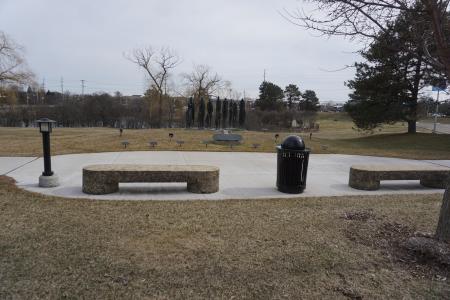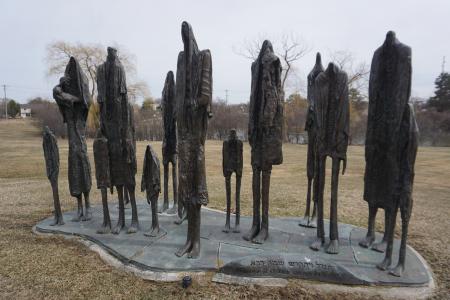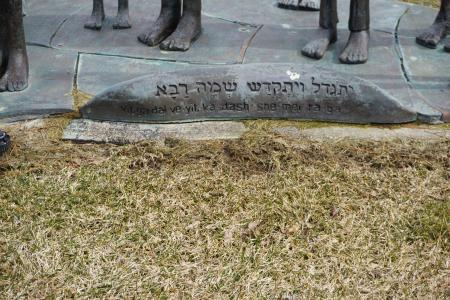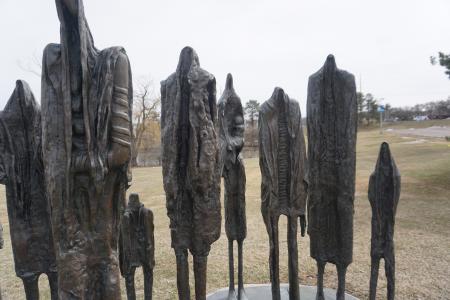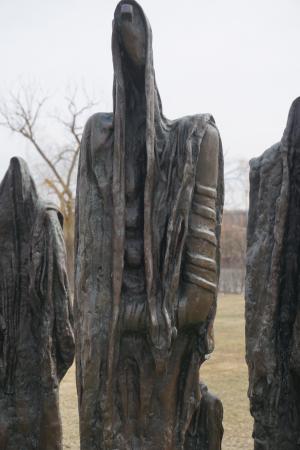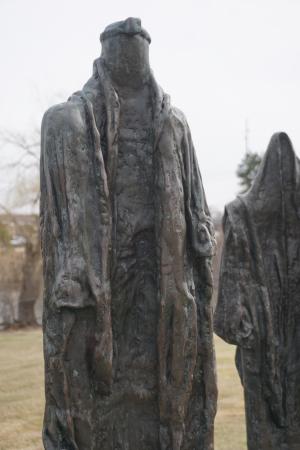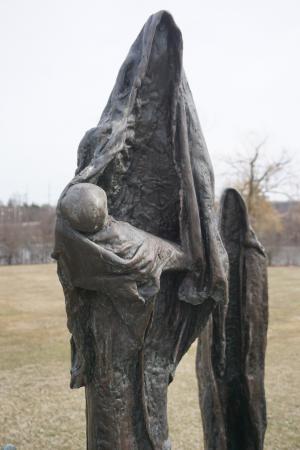Obj. ID: 48844
Memorials "The Last Kaddish" Holocaust Memorial at the Jewish Community Center of West Bloomfield Hills, MI, USA, 1990

Memorial Name
“The Last Kaddish”
Who is Commemorated?
Jewish Victims and Survivors of the Holocaust
Description
The memorial is a free-standing bronze sculpture of a group of standing figures. It is set on a grassy lawn next to the JCC and the entrance of what was formerly the Holocaust Memorial Center. The Center, now known as The Zekelman Holocaust Center, moved in 2004 to a new building in Farmington Hills, Michigan. In the space between the concrete sidewalk and the sculpture, there are placed ten small donor plaques and a larger dedication and informational plaque.
The Last Kaddish features a collection of fifteen separate thin figures, all connected at the bronze base. The base is very low, so it appears the figures are at ground level. On the front of the base, a piece of bronze rises a little higher and is inscribed in Hebrew the first four words of the Kaddish and below the transliteration into English letters.
Ten of the figures are tall and five are much smaller, suggesting children. The figures are wrapped in prayer shawls (tallitot), They all face forward. One figure on the far left holds a baby. The tall central figure wears tefillin; the straps are visible on his exposed left crooked arm and the head tefillin is upon his brow. At least one other figure wears tefillin, too.
The figures are attenuated with large feet and small heads - in the manner of the sculptor Alberto Giacometti. The figures are faceless, because, the artist said, “faces may change for each one who views the figures, but the neshama (soul) remains steadfast period to each of us, the figures in the memorial are or should be our Jewish mishpocha (family), for their soul is our soul, and together we are the survivors, which “The Last Kaddish” symbolizes. [Jewish Community Center of Metropolitan Detroit Catalog Summer 2015].
Inscriptions
On the base of the sculpture (Hebrew and transliteration):
יתגדל ויתקדש שמה רבא
Yit-ga-dal ve-yit-ka-dash she-mei ra ba
Translation (Metsudah Linear Siddur 1981): Exalted and sanctified be His great Name
On the informational plaque:
The Last Kaddish
“In the Presence of a Congregation at Worship ,God's Presence is Found”
Our interconnectedness as a People. Aharon Bezalel, the
sculptor of The Last Kaddish, utilizes this theme to
convey our survival through the bonding with God that
for the Jew takes place in the daily recital of the Kaddish.
This is not only a memorial to the six million who died
in the Holocaust, it is an expression of what he believes
to be the core of Jewish identity.
As a child in Afghanistan, whenever it was the time for
shacharis... mincha... maariv - his father, the Rabbi, would
gather ten men from the community. They would stop
their labor, face Jerusalem and start to daven, a moment
which now in Aaron's sculpture is frozen for eternity. In
The Last Kaddish he is the little boy standing at his
father's side.
At Dachau, he stood witness to the crematorium and
viewed hundreds of photographs which touched his very
neshoma, his soul. One picture was indelibly inscribed
upon his conscience and heart, that of an old Jew covered
with a tallit and wrapped into tefillin, eyes uplifted in prayer
as a Nazi soldier shot him into a grave dug by his own
hands.
Why faceless figures? The sculptor envisioned the idea
that faces may change for each one who views the figures,
but the neshoma remains steadfast. To each of us, the
figures in this memorial are - or should be - our Jewish
mishpochah, for their soul is our soul - and together we
are the survivors which The Last Kaddish symbolizes.
The Holocaust Memorial Center, with the cooperation of the Jewish Community Center,
dedicate this sculpture to the children of our community so
that they shall remember the past and prepare for the future.
On a separate plaque to the right of the sculpture:
Aharon Bezalel, sculptor
Jerusalem, Israel
1991
Commissioned By
sub-set tree:
When this sculpture was installed in 1991, the JCC housed the Holocaust Memorial Center, which moved to a new building in Farmington in 2004. The sculpture was left in place.
"Outdoor Sculptures and Monuments" Sculptures (Aharon Bezalel website), http://www.aharonbezalel.com/outdoor-sculptures-and-monuments-list.html (accessed April 16, 2023)




